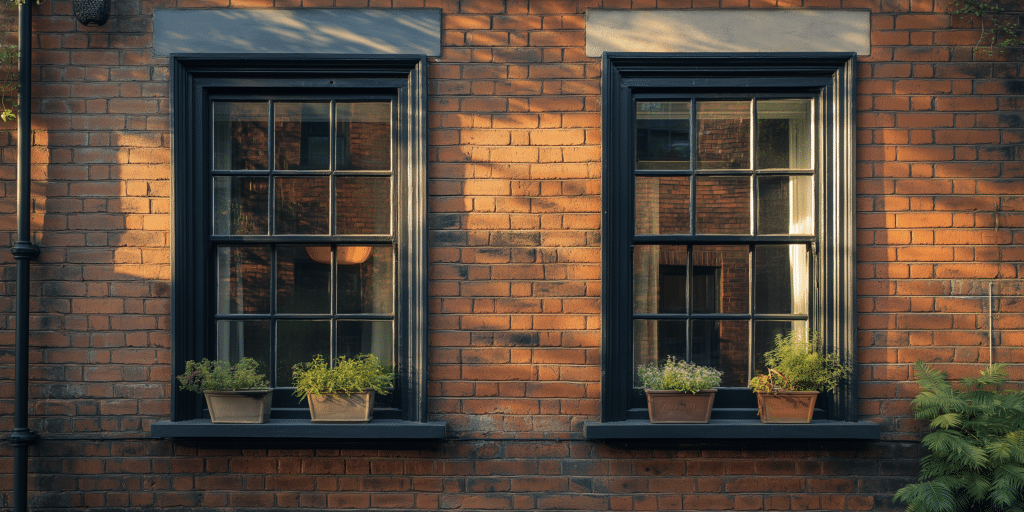What Is a Sash Window Weather Seal?

Sash windows, quintessential in British architecture, are admired for their aesthetic appeal and functional design. However, they can be prone to draughts and inefficiencies without a proper weather seal. The primary role of a sash window weather seal is to block air, moisture, and noise from penetrating through gaps in the window, ensuring an insulated environment inside your home.
Weather seals prevent rain, wind, and even dust from entering the house. They also help block external pollutants and drafts that can reduce energy efficiency. Rubber, silicone, foam strips, and brush seals are the most frequently used materials. These materials are flexible and durable, making them suitable for the varied climate of the UK. According to Energy Saving Trust, proper weather sealing can reduce heat loss by up to 20%, keeping homes warm during winter and cool during summer, thus saving on energy bills.
Types of Sash Window Weather Seals
There are various types of weather seals to choose from, and selecting the appropriate one depends on the specific needs of your sash window. The common types include brush seals, foam strips, rubber gaskets, and silicone seals, each catering to different window designs and weather conditions.
Rubber seals offer the tightest fit and durability, foam seals are easy to install and affordable, while brush seals reduce friction in sliding windows and are ideal for traditional sash windows. For listed or heritage buildings, brush seals or thinner rubber options are preferred to preserve the window’s original character while enhancing insulation. Rubber and silicone seals are long-lasting and low-maintenance, whereas foam seals may degrade faster and require frequent replacements.
How to Identify if Your Sash Window Needs a Weather Seal
Detecting signs that your sash window’s weather seal requires replacement is essential for maintaining home comfort and energy efficiency. Cracks, gaps, or peeling seals are tell-tale signs that your weather seal needs replacing. If you notice draughts despite fully closed windows, it’s likely that the weather seal has deteriorated, leading to increased energy usage.
UV exposure, humidity, and frequent sash movement can cause seals to deteriorate over time. Cold temperatures may harden seals, while moisture can lead to mould growth or cause seals to become brittle, decreasing their efficiency.
The Impact of Weather Seals on Energy Efficiency

Weather seals are critical in maintaining your home’s energy efficiency, especially in Britain’s diverse climate. According to the British Fenestration Rating Council (BFRC), proper sealing can prevent up to 40% of heat loss through windows. This reduces the need for heating and cooling systems to work harder, thus lowering energy consumption. By sealing air leaks, weather seals help reduce heat loss in the winter and heat gain in the summer, leading to savings on energy bills, which could amount to as much as £150 annually per household.
Sealing windows can help meet eco-friendly standards, such as the UK’s Building Regulations, by improving thermal performance and contributing to energy-efficient homes. Weather seals ensure that homes in colder regions retain warmth, while in warmer areas, they help keep the interior cool, thus maintaining a balanced indoor climate.
Steps to Install Weather Seals on Sash Windows
Depending on the complexity of the window, weather sealing can be a DIY project or completed by professionals. You’ll need measuring tape, utility knives, adhesive strips, and the selected weather seal material (foam, rubber, or silicone).
Step-by-step instructions for applying a weather seal to sash windows:
1. Measure the sash frame.
2. Cut the weather seal material accordingly.
3. Clean the application area.
4. Secure the weather seal with adhesive, ensuring it’s flush against the frame with no gaps.
Cleaning the frame thoroughly before application is essential for achieving an airtight seal. Make sure no gaps are left where air can leak through. Cutting the seal too short or installing it on dirty or uneven surfaces can prevent a proper seal. Ensure full coverage for maximum efficiency.
DIY vs Professional Installation: Which Is Better?
Deciding between DIY and professional installation depends on the condition of the windows and the homeowner’s experience. DIY installation is cost-effective, but it can reduce the seal’s lifespan if not done correctly. On the other hand, professional installation ensures a more durable and precise application.
For historic or large sash windows, professional help is recommended to avoid damage and ensure the weather seal integrates seamlessly with the window frame. Professionals use high-quality materials and specialised tools that enhance the seal’s durability and effectiveness, ensuring long-term insulation benefits.
DIY projects typically cost between £20-£50, while professional installation may range from £100-£300 per window, factoring in labour and high-quality materials.
Best Materials for Sash Window Weather Seals

The material chosen for weather seals greatly impacts the longevity and efficiency of the window insulation. Rubber and silicone are the most reliable and durable due to their flexibility and resistance to harsh weather conditions.
Rubber seals provide the best tightness and durability, while silicone performs well in fluctuating temperatures. Foam seals are cheaper but less durable and suitable for short-term fixes. Some materials, like rubber and uPVC, may have a higher environmental impact due to production processes. However, silicone is recyclable and often a more sustainable choice.
Silicone and rubber offer the best value as they need less frequent replacement and offer better insulation, making them cost-effective in the long run.
Weather Sealing Historical Sash Windows: Considerations and Challenges
Weather sealing historical sash windows presents distinct challenges due to the need to preserve the character of the original window design.
Sealing historic windows can be difficult as they are often irregular in shape and may have fragile frames. Preserving the original look while updating the window with modern insulation can require careful attention to detail. Many period properties have restrictions regarding the modifications that can be made. Using thinner or more discreet seals can help retain the appearance of the original sash window while ensuring it is well insulated. Materials like brush seals or thin silicone strips can be applied with minimal visual impact.
For listed buildings, using noninvasive weather seals such as brush or wool pile seals is highly recommended. These materials comply with conservation regulations while providing adequate draught-proofing. Historic England supports traditional methods for enhancing energy efficiency in heritage homes.
Modern weather seals can be customised to fit traditional sash windows without compromising function. “New weather seals are designed to be compatible with older window systems, ensuring improved insulation without impacting window movement,” says John Leech, a restoration specialist at the English Heritage Trust.
How to Maintain and Extend the Life of Weather Seals
Regular maintenance is key to ensuring your sash window weather seals remain effective over time. Regular cleaning and inspection of weather seals can help maintain their performance. Cleaning seals every few months with a soft cloth and mild detergent can prevent dirt build-up, which may compromise their effectiveness.
It’s recommended that you inspect your weather seals at least once a year or after extreme weather events. Depending on wear, replacement may be required every 3-5 years, though high-quality seals can last much longer with proper care. Factors such as prolonged exposure to UV rays, extreme cold, and excess moisture can cause weather seals to harden, crack, or deteriorate.
Cleaning seals regularly and conditioning them with silicone spray can help extend their lifespan. It removes dust and grime that can weaken seals while conditioning with silicone lubricant maintains flexibility, allowing the seals to withstand temperature changes and daily use.
Weather Seals and Noise Reduction

Aside from improving energy efficiency, weather seals can also reduce noise pollution, making your home more comfortable and peaceful.
A good weather seal blocks draughts and prevents sound waves from entering your home. Seals create an airtight barrier, blocking noise from traffic, construction, or nearby loud environments.
According to the UK Noise Association, rubber and silicone weather seals are considered the best for soundproofing because they create a tighter and more effective seal than other materials, reducing noise infiltration by up to 30%. By preventing external noise from entering through window gaps, weather seals make the indoor environment quieter and more peaceful, enhancing living conditions, especially in busy city areas.
Some seals, particularly foam-based ones, are designed to absorb vibrations, further reducing noise and protecting window stability. According to the Soundproofing Company, installing weather seals can reduce sound transmission by up to 60% in heavy-traffic areas.
Cost of Installing and Replacing Sash Window Weather Seals
The cost of installing or replacing sash window weather seals can vary based on several factors, including the size of the windows and the materials used.
- The final cost will depend on the size and complexity of the windows, the type of weather seal material, and whether you choose a DIY or professional installation. For an average-sized sash window, professional installation costs can range between £100 and £200.
- Foam seals are the least expensive, often costing as little as £20 per window, while more durable materials like silicone or rubber can increase the cost to £50-£100 per window. Specialised seals for historic buildings may cost more.
- While high-quality weather seals may have a higher initial cost, they save homeowners money in the long term by reducing energy bills and requiring less frequent replacement. According to the Energy Saving Trust, energy-efficient weather seals can reduce annual heating costs by up to 20%.
- Replacing a weather seal is often less costly than the initial installation, especially if the window frame is already prepared. Replacements typically cost between £50 and £100 per window.
Final Thoughts: The Importance of Weather Seals for Sash Windows
Weather seals play a critical role in preserving the efficiency and longevity of sash windows, especially in the UK, where seasonal changes can significantly impact home energy use. They prevent drafts and moisture from infiltrating sash windows, helping maintain the structural integrity of the frames. Timber sash windows are more prone to rotting and warping over time without proper sealing.
Properly sealed windows provide a more comfortable indoor environment by keeping temperatures consistent and reducing noise. Effective weather seals can increase a home’s value by up to 10%.
Recent advancements include thermal weather seals that adjust to changing temperatures and low-E materials that reflect heat, improving insulation. Technology is constantly evolving, with modern seals offering greater durability and efficiency than ever before. Look for seals that meet Passive House or BREEAM certifications, which ensure high energy efficiency. A professional installer applying these seals will guarantee that they meet all modern standards and perform optimally.




